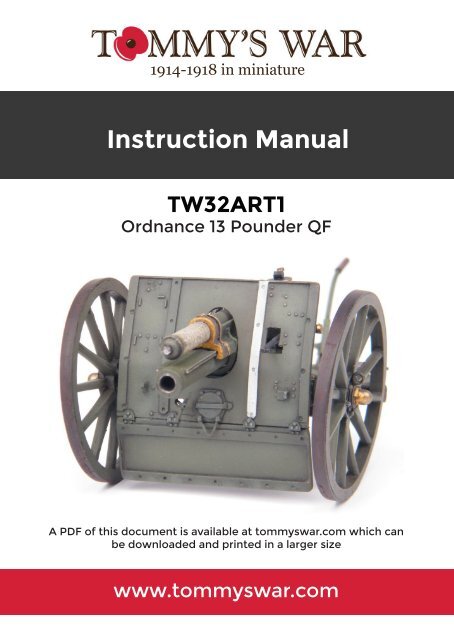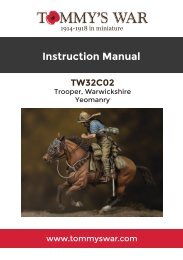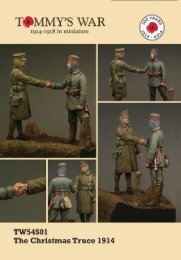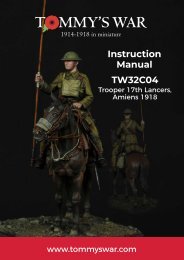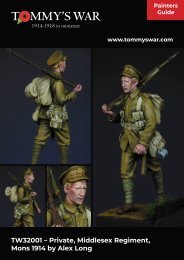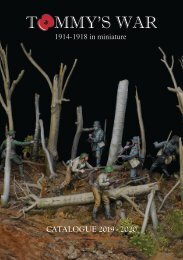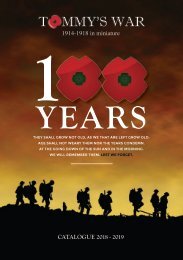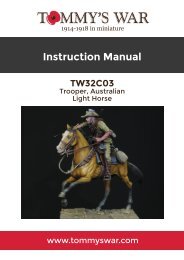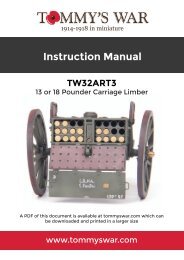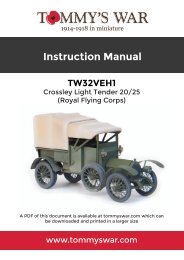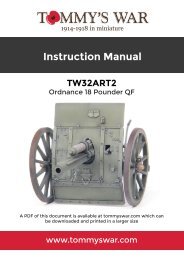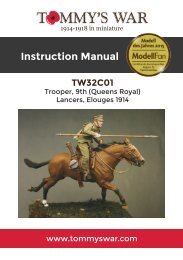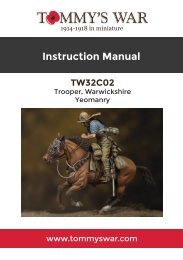TW32ART1 Ordnance Quick Firing 13 pounder gun assembly manual
This booklet gives full and detailed instructions to help the modeller assemble and complete this highly detailed kit from Tommy's War.
This booklet gives full and detailed instructions to help the modeller assemble and complete this highly detailed kit from Tommy's War.
Create successful ePaper yourself
Turn your PDF publications into a flip-book with our unique Google optimized e-Paper software.
1914-1918 in miniature<br />
Instruction Manual<br />
<strong>TW32ART1</strong><br />
<strong>Ordnance</strong> <strong>13</strong> Pounder QF<br />
A PDF of this document is available at tommyswar.com which can<br />
be downloaded and printed in a larger size<br />
www.tommyswar.com
1914-1918 in miniature<br />
Building your Kits Parts<br />
The first task is to remove molding plugs. Use a sharp craft<br />
knife, pincers or a resin saw (I use a version available from<br />
Games Workshop). Once the plugs are removed each part can<br />
be cleaned-up in detail and any mold lines removed with the<br />
craft knife or a fine sand paper*. Once you are happy with each<br />
of the individual parts then they should be cleaned with soapy<br />
water to remove any grease or fine grain and allowed to dry.<br />
It is important to pre-fit your parts before <strong>assembly</strong>, once you<br />
are happy with the way each part fits together the pieces can<br />
be affixed using an epoxy glue (generally these come in two<br />
parts, an epoxy and a hardener) or superglue. I generally use<br />
epoxy for larger parts and superglue for small sub-assemblies.<br />
There are some areas (such as fixing wheels) where it is<br />
advisable to pin, this can be achieved by using small pieces of<br />
brass rod (available at hobby stores or craft shops). This adds<br />
strength to the construction.<br />
Once the kit is built, it is advisable to give it another clean in<br />
soapy water to again remove any grease, and then prime in<br />
the colour of your choice prior to painting. Remember, resin is<br />
quite a flexible medium, and if lightly heated can be carefully<br />
manipulated in to shape.<br />
Care must be taken when working with resin as it can be<br />
dangerous if breathed in. When working with resin wear a face<br />
mask or work in a well ventilated room. We recommend a form<br />
of sanding when using resin called ‘wet-sanding’, this involves<br />
putting water on the sand paper so that resin dust is kept in the<br />
water. However, we recommend still wearing a face mask to<br />
cover the mouth area when working in this style.<br />
2<br />
www.tommyswar.com
1914-1918 in miniature<br />
Parts<br />
www.tommyswar.com<br />
3
1914-1918 in miniature<br />
Assembly<br />
4<br />
www.tommyswar.com
1914-1918 in miniature<br />
Assembly<br />
www.tommyswar.com 5
1914-1918 in miniature<br />
Assembly<br />
6<br />
www.tommyswar.com
1914-1918 in miniature<br />
Assembly<br />
www.tommyswar.com 7
1914-1918 in miniature<br />
Assembly<br />
8<br />
www.tommyswar.com
1914-1918 in miniature<br />
Assembly<br />
www.tommyswar.com 9
1914-1918 in miniature<br />
Colour schemes and references<br />
Artillery used by both the Royal Field Artillery and Royal<br />
Artillery was a shade of khaki green at the beginning of the war.<br />
Both branches of the service were highly efficient regulars and<br />
took great pride in their <strong>gun</strong>s, so upkeep and appearance was<br />
of prime importance. So, early war <strong>gun</strong>s were polished to a high<br />
standard and kept very clean.<br />
As the war progressed performance took precedence over<br />
appearance and the <strong>gun</strong>s became more weathered and<br />
camouflage from enemy counter-barrage was of vital<br />
importance. Guns were ‘dug-in’ and covered with netting and<br />
elaborate camouflage schemes became more common.<br />
For research purposes I am grateful for the outstanding and<br />
probably definitive guide to early 20th Century British artillery<br />
in the book ‘Early British <strong>Quick</strong> <strong>Firing</strong> Artillery’ by Len Trawlin<br />
(Publisher: Nexus Special Interests).<br />
For colour schemes I have referred to images of original artillery<br />
pieces (<strong>13</strong> <strong>pounder</strong> at the Imperial War Museum,London and<br />
18 <strong>pounder</strong> at the Fire power Royal Artillery Museum, London).<br />
Useful colour references can be found within the Osprey<br />
Publishing book ‘British Artillery 1914-19’by Dale Clarke and<br />
illustrated by Brian Dell published under their Vanguard range,<br />
including a very interesting pattern on an 18 <strong>pounder</strong> of the<br />
Royal Naval Division in France in 1918.<br />
Imperial War Museum - www.iwn.org.uk<br />
Firepower Museum, Woolwich, London - www.firepower.org.uk<br />
Osprey Publishing - www.ospreypublishing.com<br />
Colour photographs of our completed kits can be found at<br />
www.tommsywar.com<br />
10<br />
www.tommyswar.com
1914-1918 in miniature<br />
Replacement Parts<br />
Thank you for purchasing this Tommy’s War product, I hope you<br />
are entirely satisfied with it. I do endeavour to inspect each kit<br />
before it is despatched but on the very rare occasion that a part<br />
is missing then I will send that part to you immediately.<br />
Simply email me at Darren@tommyswar.com with a description<br />
of the part required (it may help if you can scan the instructions<br />
sheet and mark the item) and send with your postal address.<br />
www.tommyswar.com 11
1 9 1 4 - 1 9 1 8 i n m i n i a t u r e<br />
Tommy’s War Limited, 5 Athens Close<br />
Hinckley, Leicestershire LE10 1FJ United Kingdom<br />
Registered in England number 9000306<br />
Tel: +44 (0) 7958 626236<br />
Email: darren@tommyswar.com<br />
WWW.TOMMYSWAR.COM


